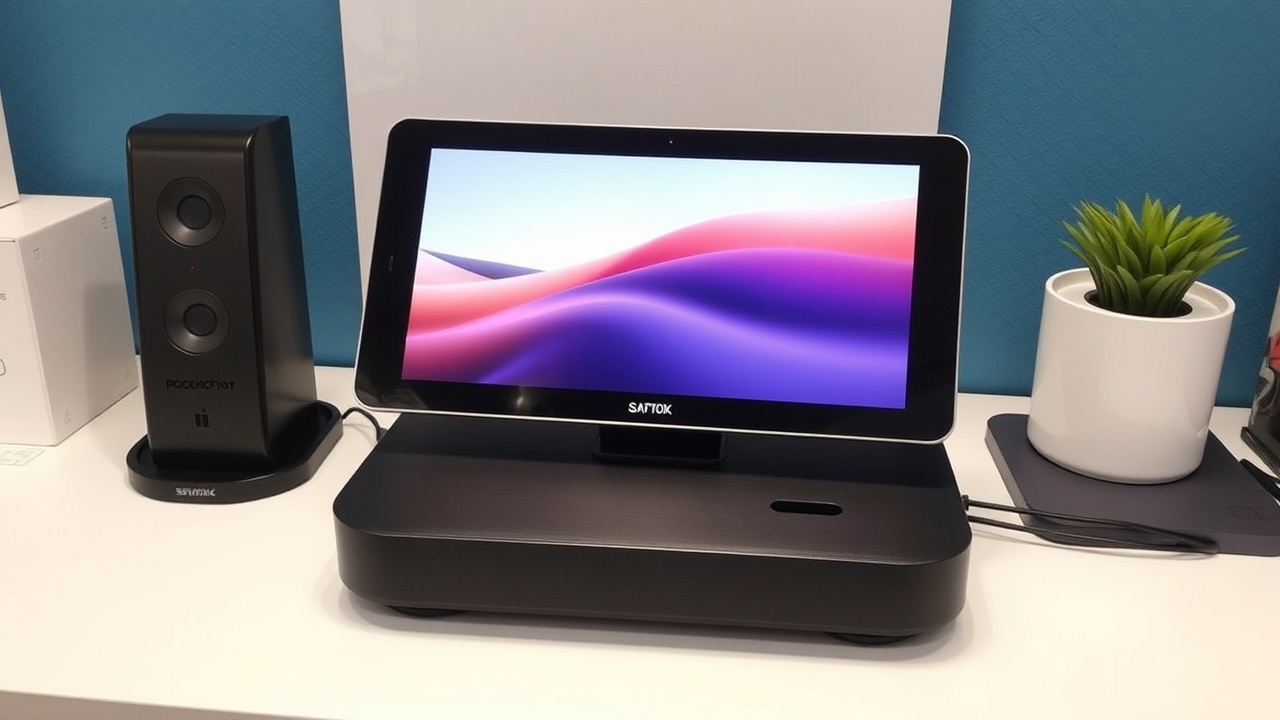In an era where technology is integral to our daily lives, the need for efficient workspace organization has never been more critical. A USB docking station serves as a central hub that connects multiple devices to a single point, significantly reducing the chaos of cables and enhancing overall productivity. One of the primary benefits of using a USB docking station is the ability to connect various peripherals—such as monitors, keyboards, mice, and external storage devices—through a single USB connection to your laptop or desktop.
This not only simplifies the physical setup but also minimizes the wear and tear on your device’s ports, which can be particularly beneficial for laptops that often have limited connectivity options. Moreover, USB docking stations often come equipped with additional features such as power delivery, which allows you to charge your devices while simultaneously using them. This dual functionality means that you can keep your workspace tidy without sacrificing performance.
For instance, many docking stations support fast charging capabilities, ensuring that your devices are always ready for use. Additionally, some models include built-in Ethernet ports for stable internet connections, which can be a game-changer for remote workers or those who rely on high-speed internet for tasks like video conferencing or large file transfers. The convenience and versatility offered by a USB docking station can transform a cluttered workspace into a streamlined environment conducive to productivity.
Key Takeaways
- Say goodbye to cable clutter and simplify your workspace with a USB docking station
- Organize your devices and streamline your workspace with the use of a USB docking station
- Choose the right USB docking station to meet your specific needs and maximize productivity
- Enjoy the benefits of a clean and efficient workspace by using a USB docking station
- Increase productivity and efficiency by utilizing a USB docking station for your devices
Organizing Your Workspace with a USB Docking Station
The physical arrangement of your workspace plays a significant role in your overall efficiency and comfort. A USB docking station can be a pivotal tool in organizing your workspace by consolidating multiple connections into one central location. Instead of having a tangle of cables snaking across your desk, a docking station allows you to connect all your devices neatly and efficiently.
This not only enhances the aesthetic appeal of your workspace but also makes it easier to access your devices without having to navigate through a mess of wires. In addition to reducing cable clutter, a USB docking station can help you create designated areas for different tasks. For example, you might set up your docking station in such a way that your monitor is positioned at eye level, while your keyboard and mouse are easily accessible.
This ergonomic arrangement can lead to improved posture and reduced strain during long working hours. Furthermore, many docking stations are designed with portability in mind, allowing you to easily move them between different workspaces or take them with you when traveling. This flexibility ensures that you can maintain an organized setup no matter where you are working.
Streamlining Your Devices with a USB Docking Station
In today’s fast-paced digital landscape, the ability to seamlessly integrate multiple devices is essential for maintaining productivity. A USB docking station acts as a bridge between various devices, allowing them to communicate and work together efficiently. For instance, if you frequently switch between a laptop and a desktop computer, a docking station can facilitate this transition by providing instant access to all your peripherals without the need for constant reconfiguration.
This capability is particularly beneficial for professionals who work in hybrid environments or need to collaborate with colleagues using different systems. Moreover, many modern USB docking stations support multiple display outputs, enabling users to extend their desktop across several monitors. This feature is invaluable for tasks that require multitasking or extensive data analysis, as it allows users to have multiple applications open simultaneously without the need to constantly switch between windows.
By streamlining device connectivity and enhancing display capabilities, a USB docking station can significantly improve workflow efficiency and reduce the time spent on mundane tasks.
How to Choose the Right USB Docking Station for Your Needs
| Feature | Criteria |
|---|---|
| Compatibility | Check if the docking station is compatible with your laptop or device |
| Ports | Consider the number and type of ports (USB, HDMI, Ethernet, etc.) you need |
| Power Delivery | Determine if the docking station provides enough power for your devices |
| Display Support | Check if the docking station supports the display resolutions and configurations you require |
| Build Quality | Look for a docking station with a durable and reliable build quality |
| Price | Consider the cost of the docking station in relation to your budget |
Selecting the right USB docking station involves considering several factors that align with your specific requirements. First and foremost, assess the types of devices you plan to connect. Different docking stations offer varying numbers of ports and compatibility with different operating systems.
For instance, if you primarily use USB-C devices, look for a docking station that supports this standard and offers multiple USB-C ports alongside traditional USB-A ports. Additionally, consider whether you need HDMI or DisplayPort outputs for connecting external monitors, as this will influence your choice. Another critical aspect to consider is power delivery capabilities.
If you rely on your laptop for extended periods without access to an outlet, opt for a docking station that provides sufficient power to charge your device while in use. Some models can deliver up to 100 watts of power, which is ideal for high-performance laptops that require more energy. Furthermore, evaluate the build quality and design of the docking station; a sturdy construction will ensure longevity and reliability over time.
By carefully considering these factors, you can select a USB docking station that not only meets your current needs but also adapts to future technological advancements.
Maximizing Productivity with a USB Docking Station

The integration of a USB docking station into your workspace can lead to significant improvements in productivity levels. By providing easy access to all necessary peripherals through a single connection point, you eliminate the time wasted on plugging and unplugging devices each time you switch tasks or locations. This streamlined approach allows you to focus more on your work rather than on managing cables and connections.
Additionally, many docking stations come equipped with features such as hot-swappable ports, enabling you to connect or disconnect devices without needing to restart your computer. Furthermore, the ability to customize your workspace layout with a USB docking station can enhance concentration and reduce distractions. With fewer cables cluttering your desk, you create an environment that fosters creativity and focus.
The ergonomic benefits of an organized workspace cannot be overstated; by positioning monitors at eye level and keeping input devices within easy reach, you can maintain better posture and reduce fatigue during long working hours. Ultimately, the combination of organization and efficiency provided by a USB docking station can lead to higher output and improved job satisfaction.
Say Goodbye to Cable Clutter: The Advantages of Using a USB Docking Station
Cable clutter is not just an aesthetic issue; it can also pose practical challenges in terms of functionality and safety. A tangled mess of cords can lead to accidental disconnections or damage to cables over time. By utilizing a USB docking station, you effectively eliminate this problem by consolidating all connections into one neat hub.
This not only enhances the visual appeal of your workspace but also reduces the risk of tripping hazards or equipment malfunctions caused by loose cables. Moreover, many USB docking stations are designed with cable management features that further enhance organization. Some models include built-in cable organizers or clips that keep cords neatly tucked away when not in use.
This thoughtful design consideration ensures that even when you’re not actively using your devices, your workspace remains tidy and professional-looking. The psychological benefits of an organized environment should not be underestimated; studies have shown that cluttered spaces can lead to increased stress levels and decreased productivity. By saying goodbye to cable clutter through the use of a USB docking station, you create an atmosphere conducive to focus and creativity.
Creating a Clean and Efficient Workspace with a USB Docking Station
A clean workspace is often synonymous with increased efficiency and productivity. The introduction of a USB docking station into your setup can play a pivotal role in achieving this cleanliness by providing an organized solution for connecting multiple devices. With all peripherals connected through one central hub, you eliminate the need for multiple power strips and tangled cords that often dominate traditional workspaces.
This streamlined approach not only enhances the visual appeal but also simplifies the process of setting up or breaking down your workstation. In addition to reducing physical clutter, a well-organized workspace can have profound effects on mental clarity and focus. When everything has its place and is easily accessible, it becomes easier to concentrate on tasks at hand without being distracted by disarray.
A USB docking station allows you to create designated areas for different activities—such as work, video calls, or creative projects—by connecting specific devices tailored for each task. This intentional organization fosters an environment where productivity thrives, enabling you to tackle challenges with greater efficiency and effectiveness. By integrating a USB docking station into your workspace setup, you not only simplify device connectivity but also cultivate an organized environment that promotes productivity and creativity.
The benefits extend beyond mere aesthetics; they encompass improved functionality, enhanced ergonomics, and ultimately a more satisfying work experience. As technology continues to evolve, embracing solutions like USB docking stations will be essential for navigating the complexities of modern work life while maintaining an efficient and enjoyable workspace.


